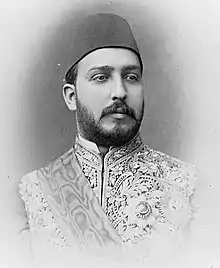The practice of conducting a periodic census began in Egypt in the second millennium BC, where it was used for tax gathering and to determine fitness for military services.
Pre-modern censuses
Pharaonic era
Censuses in Egypt first appeared in the late Middle Kingdom and develops in the New Kingdom.[1] Pharaoh Amasis, according to Herodotus, required every Egyptian to declare annually to the nomarch, "whence he gained his living".[2] Under the Ptolemies and the Romans several censuses were conducted in Egypt by government officials.[3]
Roman era
Roman censuses in Egypt estimated the population at 4.5 million inhabitants in the year 14 AD and 5 million in 164 AD.
Islamic era (600 AD)
A census also took place in the era of Hesham Abdel Malek ben Marwan in the year 600 AD including the number of people, their ages and residences.
Napoleonic era (1798)
In 1798, Egypt's population was estimated at 3 million when Napoleon invaded the country.
1848 and 1868 Censuses
After preliminary enumerations in some urban areas and villages the first countrywide census was carried out in 1848.[4][5] A modern analysis of the 1848 census records, which attempts to adjust for various discrepancies in the data, concluded that Egypt's population was 4.476 million people back then.[6] The 1848 census is said to be the first in a non-Western country to include demographic, social, and economic data on practically all individuals including females, children, and slaves. Digitization of the 1848 and 1868 census records is underway based on documents in the National Archives of Egypt.[7]
Modern censuses
Population censuses
During the last 135 years, Egypt has managed to carry out around 14 official population censuses, the first being in 1882 and the last in 2017.
| Population Censuses carried out officially in Egypt since 1882[8] | ||||||
|---|---|---|---|---|---|---|
| N.º | Year | Population | Census | Census Carried Out During | photo | |
| 1° | 1882 | 6,712,000 | 1882 Egyptian Census | Reign of the Khedive Tewfik Pasha (1879-1892) |
 (1852-1892) | |
| 2° | 1897 | 9,669,000 | 1897 Egyptian Census | Reign of the Khedive Abbas II Hilmi (1892-1914) |
.JPG.webp) (1874-1944) | |
| 3° | 1907 | 11,190,000 | 1907 Egyptian Census | Reign of the Khedive Abbas II Hilmi (1892-1914) |
 (1805-1852) | |
| 4° | 1917 | 12,718,000 | 1917 Egyptian Census | Reign of Sultan Fuad I (1917-1936) |
 (1868-1836) | |
| 5° | 1927 | 14,178,000 | 1927 Egyptian Census | Reign of Sultan Fuad I (1917-1936) |
 (1868-1836) | |
| 6° | 1937 | 15,921,000 | 1937 Egyptian Census | Reign of Sultan Faruq (1936-1952) |
 (1920-1965) | |
| 7° | 1947 | 18,967,000 | 1947 Egyptian Census | Reign of Sultan Faruq I (1936-1952) |
 (1920-1965) | |
| 8° | 1960 | 26,085,000 | 1960 Egyptian Census | Government of President Gamal Abdel Nasser (1954-1970) |
 (1918-1970) | |
| 9° | 1966 | 30,076,000 | 1966 Egyptian Census | Government of President Gamal Abdel Nasser (1954-1970) |
 (1918-1970) | |
| 10° | 1976 | 36,626,000 | 1976 Egyptian Census | Government of President Anwar El-Sadat (1970-1981) |
 (1918-1981) | |
| 11° | 1986 | 48,205,049 | 1986 Egyptian Census | Government of President Hosni Mubarak (1981-2011) |
 (1928-2020) | |
| 12° | 1996 | 59,276,672 | 1996 Egyptian Census | Government of President Hosni Mubarak (1981-2011) |
 (1928-2020) | |
| 13° | 2006 | 72,798,031 | 2006 Egyptian Census | Government of President Hosni Mubarak (1981-2011) |
 (1928-2020) | |
| 14° | 2017 | 94,798,827 | 2017 Egyptian Census | Government of Marshal Abdel Fattah el-Sisi (2014-Presente) |
.jpg.webp) (1954-) | |
| - | 2022 | 103,011,914 | Estimates CAPMAS[9] | |||
| Census Year |
Population[10] (in thousands) |
Arithmetic Density[11] (inhabitants/km2) |
|---|---|---|
| 1882 | 6,712 | 6.65 |
| 1897 | 9,669 | 9.58 |
| 1907 | 11,190 | 11.09 |
| 1917 | 12,718 | 12.60 |
| 1927 | 14,178 | 14.05 |
| 1937 | 15,921 | 15.78 |
| 1947 | 18,967 | 18.79 |
| 1960 | 26,085 | 25.84 |
| 1966 | 30,076 | 29.79 |
| 1976 | 36,626 | 36.28 |
| 1986 | 48,254 | 47.80 |
| 1996 | 59,312 | 58.76 |
| 2006 | 72,798 | 70.70 |
1882
- 1882 — The first census in Egypt had been carried out. The total population was 6.7 million.
1947
- According to the 1947 census, Egypt's population had reached 19 million inhabitants.[12]
| Province or governorate | Population (1947 census) |
|---|---|
| Alexandria | 928,237 |
| Aswan | 285,551 |
| Asyut | 1,379,875 |
| Beheira | 1,242,478 |
| Beni Suef | 613,365 |
| Cairo | 2,100,486 |
| Dakahlia | 1,366,085 |
| Damietta | 124,104 |
| Faiyum | 671,885 |
| Frontiers | 216,872 |
| Gharbia | 2,316,619 |
| Girga (currently Sohag Governorate) | 1,288,425 |
| Giza | 822,424 |
| Ismailia | 132,810 |
| Minya | 1,061,417 |
| Monufia | 1,168,777 |
| Port Said | 178,432 |
| Qalyubia | 687,169 |
| Qena | 1,106,296 |
| Sharqia | 1,290,890 |
| Suez | 108,250 |
| Total population | 19,090,447 |
1976
- A census in 1976 revealed that the population had risen to 36.6 million.
1986
- In 1986, a census indicated that the population of Egypt reached a total of 50.4 million, including about 2.3 million Egyptians working in other countries.
1996
- In 1996, the census found a population of 59.3 million.
2006
- In 2006, the thirteenth census in the Egyptian census series revealed that the Egypt's population hit 76.5 million inside and outside the country.
2017
A new census was done in 2017. Census day was 18 April 2017 and Egypt's population on that date was estimated to be 94,798,827.[13]
Latest census details (2006)
Nationwide demographics
| Statement | Total country |
|---|---|
| % Change in Population compared with Census 1996 | % 22 |
| % Change in Population Under 6 Years Old | % 168 |
| % Change in Population Under 15 Years Old | % 256 |
| % Change in Population Over 45 Years Old | % 289 |
| Number of Households | 17,265,567 |
| Household Population | 72,131,096 |
| Family average | 4 to 5 |
| Number of university graduates | 5,476,704 |
| Number of Illiterates 2006 | 16,806,657 |
| Raw Birth Rate | 26 |
| Raw Death Rate | 6 |
Population by sex and residence
| Residence | Males | Females | Total |
|---|---|---|---|
| Urban areas | 1 | 1 | 1 |
| Rural areas | 1 | 1 | 1 |
| Total Egypt | 1 | 1 | 1 |
Population by governorate
| Governorate | 1996 | 2006 | Change % |
|---|---|---|---|
| Cairo | 6,800,991 | 7,786,640 | 14.49 |
| Giza | 4,784,095 | 6,272,571 | 31.11 |
| Sharqia | 4,281,068 | 5,340,058 | 24.74 |
| Dakahlia | 4,223,338 | 4,985,187 | 18.04 |
| Beheira | 3,994,297 | 4,737,129 | 18.6 |
| Gharbia | 3,404,339 | 4,010,298 | 17.8 |
| Alexandria | 3,339,076 | 4,110,015 | 23.09 |
| Minya | 3,310,129 | 4,179,309 | 26.26 |
| Qalyubia | 3,281,135 | 4,237,003 | 29.13 |
| Sohag | 3,123,114 | 3,746,377 | 19.96 |
| Asyut | 2,802,334 | 3,441,597 | 22.81 |
| Monufia | 2,760,429 | 3,270,404 | 18.47 |
| Qena | 2,442,016 | 3,001,494 | 22.91 |
| Kafr el-Sheikh | 2,223,383 | 2,618,111 | 17.75 |
| Faiyum | 1,989,772 | 2,512,792 | 26.29 |
| Beni Suef | 1,859,213 | 2,290,527 | 23.2 |
| Aswan | 960,510 | 1,184,432 | 23.31 |
| Damietta | 913,555 | 1,092,316 | 19.57 |
| Ismailia | 714,828 | 942,832 | 31.9 |
| Port Said | 472,331 | 570,768 | 20.84 |
| Suez | 417,526 | 510,935 | 22.37 |
| Luxor | 361,138 | 451,318 | 24.97 |
| North Sinai | 252,160 | 339,752 | 34.74 |
| Matruh | 212,001 | 322,341 | 52.05 |
| Red Sea | 157,314 | 288,233 | 83.22 |
| New Valley | 141,774 | 187,256 | 32.08 |
| South Sinai | 54,806 | 149,335 | 172.48 |
| Total Egypt | 59,276,672 | 72,579,030 | 22.44 |
Future projections
At current pace, Egypt's population is expected to reach 160 million by 2050. However, if the current rate of reproduction diminishes, the population may be limited to 120 million by 2050. Egypt already has one of the highest real population densities in the world.[14]
See also
References
- General
- https://web.archive.org/web/20070930225811/http://www.sis.gov.eg/En/EgyptOnline/Miscellaneous/000002/0207000000000000001038.htm
- https://web.archive.org/web/20070928001729/http://www.sis.gov.eg/En/EgyptOnline/Miscellaneous/000002/0207000000000000001446.htm
- http://countrystudies.us/egypt/55.htm
- https://web.archive.org/web/20070930230227/http://www.sis.gov.eg/En/Pub/yearbook/yearbook2006/110104000000000001.htm
- http://www.citypopulation.de/Egypt.html
- http://scriptorium.lib.duke.edu/papyrus/records/971r.html
- CAPMAS website
- Specific
- ↑ D. Valbelle. "Les recensements dans l'Egypte pharaonique des troisième et deuxième millénaires" CRIPEL 9 (1987) 37 - 49.
- ↑ Herodotus, Histories II, 177, 2
- ↑ Paul Cartledge, Peter Garnsey, Erich S. Gruen Hellenistic Constructs: Essays in Culture, History, and Historiography 242 ss.
- ↑ Cuno, Kenneth M.; Reimer, Michael J. (1997). "The Census Registers of Nineteenth-Century Egypt: A New Source for Social Historians". British Journal of Middle Eastern Studies. Taylor & Francis, Ltd. 24 (2): 193–216. doi:10.1080/13530199708705646. JSTOR 195772.
- ↑ Fargues, Philippe. Family and household in mid-nineeenth century Cairo. In Doumani, Beshara, ed. Family history in the Middle East: household, property, and gender
- ↑ Alleaume, G. and P. Fargues. 1998. La naissance d'une statistique d'état. Histoire & Mesure 13: 147-193
- ↑ Saleh, Mohamed. "A Pre-Colonial Population Brought to Light: Digitization of the Nineteenth Century Egyptian Censuses," Historical Methods 46:1 (January 2013) 5-18. (online draft)
- ↑ egypt.unfpa.org (June 2018). "National Report of Egypt by census". Retrieved 16 July 2020.
- ↑ monitordeoriente.com (26 February 2022). "La población de Egipto alcanza los 103 millones de habitantes". Retrieved 17 March 2022.
- ↑ "Population in Censuses By Sex & Sex Ratio (1882–2006)" (PDF). Egypt in Figures 2010. Central Agency for Public Mobilization and Statistics. p. 6. Archived from the original (PDF) on 2011-07-23. Retrieved 2011-04-17.
- ↑ Osman, Maged (11–17 May 2006). "No strength in numbers". Al-Ahram Weekly (794). Archived from the original on 2011-04-03. Retrieved 2011-04-17.
- ↑ Shousha, Aly Tewfik (1947). "Cholera Epidemic in Egypt: A Preliminary Report". Bull. World Health Organ. 1 (2): 371. PMC 2553924. PMID 20603928.
- ↑ "الجهاز المركزي للتعبئة العامة والإحصاء" (PDF). www.capmas.gov.eg. Retrieved 13 October 2017.
- ↑ "Egypt weighed down by population woes". AFP. 10 June 2008. Archived from the original on 2011-04-25. Retrieved 2011-04-18.